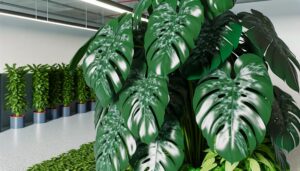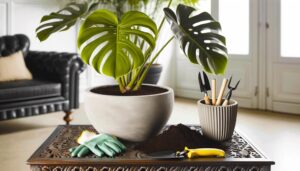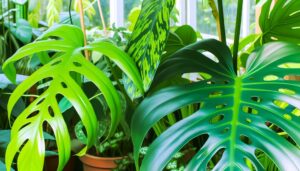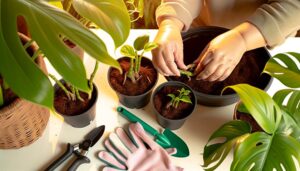Monstera Dubia Light Requirements
To cultivate a thriving Monstera Dubia, ensure it receives 6-8 hours of indirect, filtered sunlight daily, mimicking its tropical rainforest habitat. Avoid direct sunlight to prevent leaf burn, using sheer curtains to diffuse any intense rays.
Position the plant near an east or north-facing window for prime light. If natural light is insufficient, supplement with grow lights maintaining a PAR value between 200-400 µmol/m²/s.
Monitor for signs of light stress such as yellowing or elongated leaves, and adjust accordingly. Continue exploring to master the ideal light conditions and promote healthy growth.
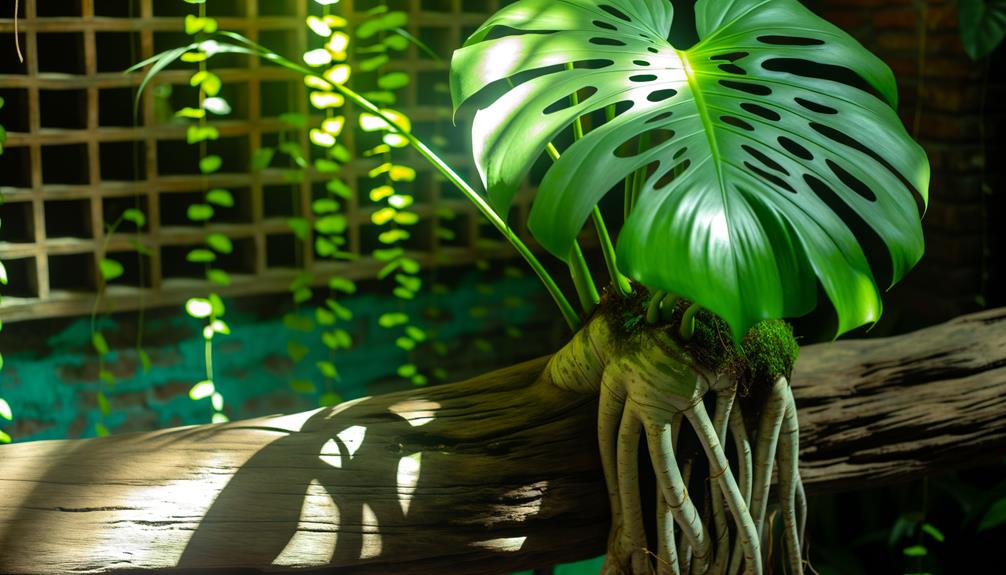
Key Takeaways
- Provide 6-8 hours of indirect, filtered sunlight daily to avoid leaf burn.
- Position in north-facing windows or use sheer curtains to scatter intense rays.
- Use grow lights with 200-400 µmol/m²/s PAR for 12-14 hours during low light seasons.
- Avoid direct afternoon sunlight; morning light is gentler and beneficial.
- Monitor for light stress signs like yellowing or browning leaves and adjust light accordingly.
Natural Habitat and Light
In its natural habitat, Monstera dubia thrives under the dappled light filtering through the dense canopy of tropical rainforests. You'll find it clinging to the trunks of trees, utilizing its aerial roots to anchor and climb. This epiphytic growth habit allows it to access moderate light levels without direct sun exposure, which can be harmful.
The plant's leaves are adapted to these conditions, featuring a fenestrated structure that maximizes light capture while minimizing damage from intense light. By understanding this natural environment, you can better replicate the necessary conditions for Monstera dubia in cultivation. Providing similar light filtering through sheer curtains or positioning the plant in a shaded area will facilitate healthy growth and mimic its native habitat.
Ideal Light Intensity
To ensure Monstera dubia thrives, aim to provide light intensity equivalent to a north-facing window or an area receiving indirect, filtered sunlight for about 6-8 hours daily. This maximizes the plant receives adequate photosynthetically active radiation (PAR) without exposure to direct sun, which can cause photoinhibition.
Follow these guidelines for prime light intensity:
- Positioning: Place your Monstera dubia away from direct sunlight, ideally near sheer-curtained windows.
- Light Meter: Use a light meter to measure PAR, aiming for 100-200 µmol/m²/s.
- Artificial Light: If natural light is insufficient, supplement with full-spectrum grow lights.
- Monitoring: Regularly check your plant for signs of light stress, such as leaf discoloration or legginess.
Morning Vs. Afternoon Sun
You need to take into account the intensity variations between morning and afternoon sun when placing your Monstera Dubia. Morning sun provides gentler light, reducing the risk of leaf burn, while afternoon sun can be too strong and harmful.
For the best placement, make sure your plant receives filtered morning light to promote healthy growth.
Light Intensity Variations
Morning sunlight provides Monstera Dubia with milder light intensity, which reduces the risk of leaf burn compared to the stronger afternoon sunlight. This plant thrives in bright, indirect light, but excessive direct sunlight, particularly in the afternoon, can result in photooxidative stress.
To optimize your Monstera Dubia's health:
- Place it in a spot where it receives filtered morning light.
- Avoid placing it in direct afternoon sunlight, as this may cause cellular damage.
- Use sheer curtains to scatter intense rays if the plant is positioned near a window facing west or south.
- Rotate the plant periodically to guarantee uniform light exposure and prevent phototropic bending.
Sunlight Duration Impact
Understanding the impact of sunlight duration on Monstera Dubia is essential, as prolonged exposure to afternoon sun can lead to significant photoinhibition and cellular damage. Morning sun provides gentler light, allowing for best photosynthetic activity without risking the plant's health. Afternoon sunlight, however, is more intense and can overwhelm Monstera Dubia's chloroplasts, causing reduced efficiency and potential burning.
| Sunlight Type | Impact on Photosynthesis | Plant Health Risk |
|---|---|---|
| Morning Sun | Best supports | Low |
| Afternoon Sun | Causes photoinhibition | High |
| Prolonged Exposure | Cellular damage | Severe |
Optimal Placement Tips
To optimize Monstera Dubia's growth, strategically place it where it can primarily receive morning sunlight while avoiding direct afternoon exposure. Morning sunlight is less intense and provides the necessary photosynthetically active radiation (PAR) without causing photodamage. Direct afternoon sun can lead to photoinhibition and leaf scorch.
Consider these placement tips:
- East-facing windows: Ideal for capturing gentle morning rays.
- Filtered light: Use sheer curtains to diffuse harsh light if western exposure is unavoidable.
- Distance from windows: Position the plant at least 3 feet away from west or south-facing windows.
- Utilize shade: Employ blinds or shades during peak afternoon hours to reduce light intensity.
Indirect Light Benefits
You'll find that providing indirect light to your Monstera Dubia greatly enhances its growth rate by optimizing photosynthesis without causing stress.
This type of light promotes healthier leaf development, preventing issues like chlorosis.
Additionally, indirect light reduces the risk of leaf burn, ensuring your plant maintains its aesthetic appeal.
Healthier Leaf Development
Indirect light helps Monstera Dubia's leaves develop with the most chlorophyll concentration, enhancing photosynthetic efficiency and overall plant health. When you provide your plant with indirect light, you create ideal conditions for leaf pigmentation and structure. This type of lighting minimizes the risk of photodamage, allowing the leaves to maintain their vibrant green color and unique fenestrations.
For healthier leaf development, consider the following benefits of indirect light:
- Enhances chlorophyll synthesis: Maximizes photosynthetic capacity.
- Decreases photoinhibition: Prevents damage from excessive light intensity.
- Promotes uniform growth: Encourages even light distribution across foliage.
- Balances moisture levels: Reduces excessive transpiration and water loss.
Enhanced Growth Rate
With the most suitable exposure to indirect light, Monstera Dubia exhibits a significantly improved growth rate, driven by enhanced photosynthetic efficiency and reduced stress factors.
Indirect light enhances chlorophyll function, ensuring that your plant absorbs the maximum amount of light without the risk of photoinhibition. This ideal light exposure boosts the Calvin cycle, resulting in increased glucose production, which fuels cellular activities and growth.
Additionally, indirect light minimizes photodamage, allowing the plant to allocate more resources to growth rather than repair mechanisms. You'll notice more vigorous climbing and larger, healthier leaves as the plant efficiently converts light energy into growth-promoting compounds.
Reduced Leaf Burn
By providing Monstera Dubia with indirect light, you greatly reduce the risk of leaf burn, safeguarding the plant's photosynthetic tissues remain intact and functional. Direct sunlight can cause photodamage, leading to necrosis and chlorosis. Indirect light mimics the plant's natural understory habitat, fostering peak growth conditions and preventing cellular damage.
To achieve this, you should:
- Position the plant near a north or east-facing window: This guarantees it receives gentle, filtered light.
- Use sheer curtains: They scatter intense sunlight, shielding the leaves.
- Rotate the plant regularly: This encourages even light distribution, preventing lopsided growth.
- Monitor leaf coloration: Yellowing or browning tips indicate excessive light exposure, signaling the need for adjustment.
Adopting these practices will keep your Monstera Dubia thriving.
Avoiding Direct Sunlight
Promoting the thriving of your Monstera Dubia involves regularly placing it away from direct sunlight to prevent leaf burn and stress. Direct sunlight can cause photoinhibition, which hinders photosynthesis, resulting in chlorosis and necrosis on the leaves.
Position your plant in a spot with bright, indirect light, ideally close to an east- or north-facing window. Use sheer curtains or blinds to scatter sunlight if needed. Regularly check leaf coloration and texture; yellowing or browning indicates excessive light exposure.
Rotate the plant periodically to ensure uniform light distribution, preventing lopsided growth. Keep in mind, Monstera Dubia naturally flourishes under the filtered canopy of tropical rainforests, so recreating this setting is crucial for its peak health and robust growth.
Using Grow Lights
When natural light conditions are insufficient, using grow lights can effectively supplement the lighting needs of your Monstera Dubia. Choose full-spectrum LED grow lights, as they mimic natural sunlight and promote ideal photosynthesis. Position the grow light 12-18 inches above the plant to avoid leaf burn but ensure sufficient light penetration.
Follow these steps for best results:
- Duration: Provide 12-14 hours of light daily.
- Intensity: Use lights with a PAR value between 200-400 µmol/m²/s.
- Spectrum: Opt for a balanced red and blue light ratio to support both growth and foliage development.
- Cycle: Implement a consistent on/off cycle to mimic natural day-night rhythms.
Regularly monitor your Monstera Dubia for signs of light stress or deficiency.
Seasonal Light Changes
Understanding how seasonal light changes affect your Monstera Dubia is important for maintaining best growth and health throughout the year.
During winter months, daylight hours shorten, reducing the intensity and duration of natural light. Your Monstera Dubia may require supplemental lighting to compensate.
Conversely, summer brings longer daylight hours and increased light intensity, necessitating careful monitoring to prevent light stress. Place your plant in a location offering bright, indirect light, avoiding direct sunlight exposure to protect its foliage.
Adjust positioning seasonally—closer to windows in winter and slightly further away during summer. Consistent light levels support ideal photosynthesis, ensuring robust growth.
Signs of Too Much Light
When your Monstera Dubia gets too much light, you'll notice specific signs like leaf discoloration patterns, such as yellowing or bleaching.
Browning leaf edges are another indication, often resulting from leaf tissue damage.
Additionally, excessive light can cause wilting and drooping, indicating stress and dehydration in the plant.
Leaf Discoloration Patterns
Excessive light exposure often appears in Monstera dubia leaves as yellowing or browning around the edges and tips, indicating potential photodamage. You'll notice these discoloration patterns as the plant's chlorophyll degrades, affecting photosynthesis efficiency.
To help you identify and manage these signs, consider the following:
- Yellowing Edges: Initial yellowing suggests mild photodamage.
- Browning Tips: Browning indicates more severe light stress.
- Interveinal Chlorosis: Yellowing between veins shows chlorophyll breakdown.
- Leaf Curling: Leaves may curl to reduce light exposure.
Adjust your plant's light conditions to prevent further damage. Reduce direct sunlight and ensure diffused light exposure for best growth. Monitoring these signs helps maintain your Monstera dubia's health and vibrancy.
Browning Leaf Edges
Browning leaf edges on your Monstera dubia signal severe photodamage, indicating that the plant is receiving too much intense light. Excessive light exposure triggers a physiological stress response, causing leaf cells to dehydrate and their edges to brown.
You should immediately relocate the plant to a spot with indirect, filtered light, avoiding direct sunlight. Make sure the light intensity is within the ideal range of 100-200 foot candles. Using a light meter can help you measure this accurately.
Additionally, maintain ambient humidity around 60-80% to mitigate further dehydration. Regularly monitor your Monstera dubia for signs of recovery, such as new, healthy leaf growth, and adjust the lighting conditions as needed to prevent future photodamage.
Wilting and Drooping
In conditions of excessive light exposure, your Monstera dubia will exhibit wilting and drooping as a physiological response to mitigate water loss and stress. When the plant receives too much light, it increases transpiration rates, leading to rapid water depletion. This forces the leaves to wilt and droop in an effort to conserve moisture.
To identify and address this issue, observe the following signs:
- Leaf Curling: Leaves curl inward to reduce surface area exposed to light.
- Leaf Discoloration: Faded or bleached leaf appearance.
- Leaf Dryness: Crispy texture due to dehydration.
- Stunted Growth: Reduced leaf size and slower growth rate.
Adjust the light conditions by moving your Monstera dubia to a less intense light environment for the best health.
Signs of Insufficient Light
When your Monstera Dubia doesn't receive sufficient light, its growth stalls, and the plant exhibits elongated, pale leaves as it stretches toward the light source. This phenomenon is known as etiolation.
You may notice smaller, thinner leaves that lack the vibrant green pigmentation typical of a healthy Monstera Dubia. The stems become weak and leggy, compromising the plant's overall structural integrity. Additionally, inadequate light can lead to a decrease in photosynthesis, further hindering growth.
Keep an eye out for slow development and a general lack of vigor. If left unaddressed, these signs can exacerbate, making recovery more difficult.
Regularly monitoring and adjusting light conditions can prevent these issues and guarantee your Monstera Dubia thrives.
Positioning in Your Home
To maximize growth, place your Monstera Dubia in a location where it receives bright, indirect light for the majority of the day. Direct sunlight can scorch its leaves, so avoid spots with intense, direct rays.
Consider the following placement options in your home:
- East-Facing Windows: These provide gentle, morning sunlight.
- North-Facing Windows: Ensure consistent, indirect light throughout the day.
- South-Facing Windows: Position the plant a few feet away to avoid direct midday sun.
- West-Facing Windows: Be cautious of the strong afternoon sun; use sheer curtains to diffuse light.
Monitoring light levels with a light meter can help you maintain prime conditions. Proper positioning guarantees your Monstera Dubia thrives, maintaining its vibrant foliage and robust growth.
Adjusting for Growth
As your Monstera Dubia matures, you'll need to periodically adjust its positioning to make sure it continues receiving ideal light for vigorous growth. Monitor the plant's phototropic response, watching for any signs of etiolation or uneven leaf development. If you observe elongated stems or reduced leaf size, these are indicators of insufficient light.
Conversely, if leaves show signs of chlorosis or sunburn, the light intensity is excessive. Rotate the plant every few weeks to guarantee balanced light exposure on all sides, promoting symmetrical growth. Adjust the distance from light sources as the plant grows taller, ensuring it remains within the best light spectrum.
Consistent monitoring and adjustments will promote healthy, robust development in your Monstera Dubia.
Conclusion
To wrap up, ensuring your Monstera dubia receives the right light can greatly impact its growth and health.
Did you know that plants receiving ideal indirect light can grow up to 30% faster than those in low light conditions?
By avoiding direct sunlight and fine-tuning positioning based on growth signs, you'll help your Monstera dubia thrive.
Remember, a well-lit environment mimics its natural habitat, promoting vibrant foliage and robust development.
Keep adjusting as needed to maintain ideal light exposure.


